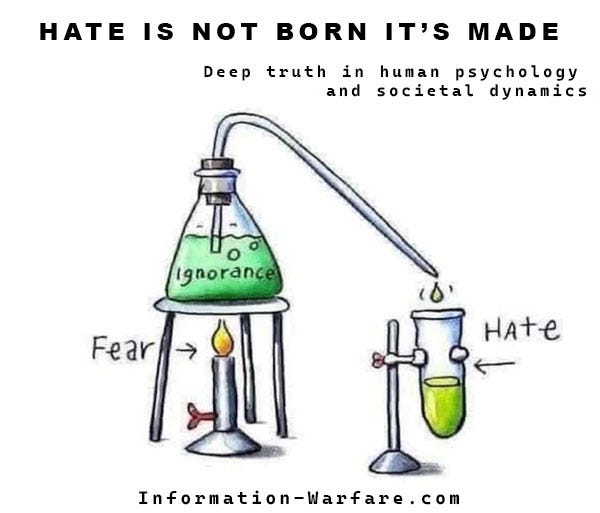The Alchemy of Hate
How Ignorance and Fear Fuel Division in the Age of Information
In an age of rapid communication, political polarization, and rising global tensions, the anatomy of hate remains largely unchanged. A simple but profound image circulating online recently distilled this enduring truth into a metaphor so effective it could be taught in classrooms and debated in parliaments: Ignorance + Fear = Hate.
The illustration, styled like a chemistry experiment, shows fear as the flame beneath a flask labeled "ignorance." As the contents are heated, a toxic fluid drips into a test tube marked "hate." It’s a vivid, almost playful depiction of a deadly serious process—how hatred is brewed in both individual hearts and collective cultures.
Ignorance: The Base Element
Ignorance is not simply the absence of knowledge—it’s often a lack of understanding shaped by isolation, cultural silos, or a deliberate refusal to engage with new perspectives. When we don’t understand another person's culture, religion, identity, or experience, it becomes easier to reduce them to caricatures or threats. In this way, ignorance lays the foundation for fear, ripe for manipulation.
In the modern world, ignorance is both harder and easier to cultivate. On one hand, the internet provides access to more information than any generation before us. On the other hand, disinformation, echo chambers, and algorithmic filters often prevent us from encountering anything that challenges our views. Knowledge is available—but not always accessed or trusted.
Fear: The Accelerant
Fear is a powerful evolutionary response. It can protect us in times of danger—but when applied to social and political issues, it becomes a tool of control. Politicians, media personalities, and ideological influencers often exploit this by stoking fear of the “other”—immigrants, minorities, religious groups, political opponents. These fears are rarely rooted in reality; they’re projections of the unknown, fueled by narratives crafted to divide.
Fear does more than spark hate—it justifies it. It convinces people that hostility is defense, that cruelty is caution, and that violence is security. It moves individuals from passive ignorance to active aggression. The flame grows hotter, and the toxic byproduct begins to drip.
Hate: The Byproduct
Hate is not born. It is made.
It is a chemical reaction—of emotion over reason, of tribalism over unity, of disinformation over understanding. Hate closes minds, hardens hearts, and fractures societies. And just like in the lab image, it’s not something that stands alone—it is created, distilled, and reinforced.
When hate enters public discourse, it transforms politics into war, neighbors into enemies, and compassion into weakness. It is addictive and self-reinforcing. And once produced, it doesn’t remain in the lab. It spills over into families, communities, and nations.
Breaking the Cycle: Dismantling the Lab
If hate is the result of ignorance and fear, then the antidote must begin with education and empathy.
Educate: The most powerful weapon against ignorance is learning—about history, science, each other. Education should not just teach facts, but how to think critically, ask questions, and challenge biases.
Think: In the age of information warfare, the ability to analyze and reflect is more vital than ever. Algorithms will not do it for us. We must cultivate independent thought and moral reasoning.
Listen: Dialogue—not debate—is essential. Listening doesn’t mean agreeing, but it requires openness. It breaks down the assumptions that fear thrives on.
Empathize: True empathy is an act of radical imagination—to see through someone else’s eyes, feel with their heart, and recognize their humanity as equal to our own.
Conclusion: A Call to Civic Alchemy
The transformation of hate into healing is possible—but it will take a different kind of alchemy. One not practiced in secret labs of manipulation, but in open spaces of dialogue, community, and truth. If we are to survive this era of division, we must reclaim our shared humanity not as an abstract ideal, but as an everyday practice.
Hate is not a mystery. We know how it’s made. And that means we know how to unmake it, too.


